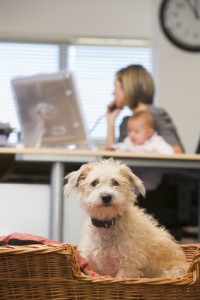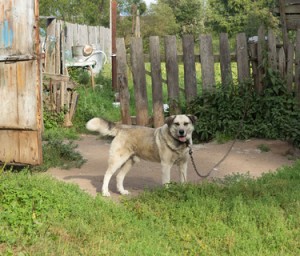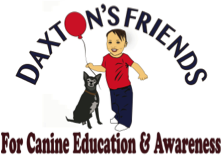KEEPING YOUR FAMILY SAFE AROUND DOGS
 DO RESEARCH BEFORE BRINGING HOME A FAMILY DOG
DO RESEARCH BEFORE BRINGING HOME A FAMILY DOG
Take your time when selecting a family dog. Talk with your family about what they want and expect in a family pet. Think about the aspects of a dog’s personality, appearance, and breed that are important to your family. Do proper research into dog ownership and the types of breeds available. Take the family to visit dogs at shelters, breeders and pet stores to get a basic idea of what you may be looking for in a dog. Never impulse purchase a dog. Take your time deciding and only purchase a dog once you are positive that the dog fits all your criteria. The dog should get along well with all members of the family.
BE AWARE OF THE DOGS THAT YOUR FAMILY MAY ENCOUNTER
Very often adults and children are bitten or harmed by a dog they are visiting. Before you agree to visit a residence, always make sure you are aware of the dogs living in the household. Ask questions about the dog before meeting it. Inquire about the where the dog came from, its background, and its breed. Do proper research before visiting the household. If you are leaving your children at the residence without your direct supervision, make sure you have all the info needed about the dog well in advance and meet the dog in person beforehand. There have been several instances of children being harmed or killed because a dog was added to the residence without the parent’s prior knowledge. If you have any reservations about your children being around the dog, politely decline the invitation. It is always better to err on the side of caution than have your children injured.
LOOSE DOGS
Always be cautious around dogs running loose, especially if you are unfamiliar with the dog. Gauge the dog’s body language from a distance before approaching the dog. A dog that appears to have stiff movements, intense stares, and tight tail wagging may be dangerous to approach. If you are uncertain about the dog, the safest option is to call your local police department or sheriff’s office, and report the dog. If you would still like to assist a loose dog safely, drive around the neighborhood asking neighbors if they know to whom the dog belongs and let them know of the dog’s estimated location. This may help reunite the dog with its family quickly and safely.
If loose dogs are a frequent or regular problem in your neighborhood, we suggest that you and your neighbors contact a city council member and/or the mayor.
NEVER APPROACH AN EATING DOG
One of the most common forms of dog aggression is resource guarding. This is when a dog values an object so much they are willing to bite a person or other animal to retain control over said object. This is commonly seen when dogs are eating and when they are chewing on bones, rawhides, or toys. Children are the most common victims of this type of aggression and should be taught at an early age to stay clear of a dog under these circumstances.
ALWAYS ASK BEFORE PETTING A DOG
It is wise to engage in conversation with a dog owner before approaching a dog closely or petting it. By talking to the owner first from a safe distance you can judge the dog to see if it seems welcoming to you approaching. Dogs that are hard barking or growling may not want you to come closer and may need to be approached very cautiously. When conversing with the owner, ask if you can approach the dog or pet it. Respect the owner’s wishes if they decline your request. They may have a very good reason for you not to approach. If an owner allows you to approach it is still important to be cautious. If the dog gives signals such as staring, hard barking, or growling it should be avoided despite what the owner may say. Just because an owner states their dog is friendly, does not mean it is. If the owner allows you to approach and the dog signals are appropriate, let the dog sniff your hand before petting it. Make your movements slowly so you do not scare or startle the dog. Teach children to always follow these steps before petting a dog.
PLAYING WITH A DOG
It is important to play with a dog appropriately and cautiously. It is best to play simple games such as fetch and steer clear of games that might encourage an incident of biting, even if it is purely accidental. A common game that often leads to injuries is tug of war. This is where the dog is tugging on the end of a toy while the person holds the other end. While the dog is tugging they may readjust their grip and a person’s fingers may be bitten or nipped. Tug of war can also over stimulate a dog. When a dog is over stimulated what started off as play can become aggressive behaviors. The dog might start to jump on the person or purposely bite them, most commonly the arm that was holding the toy. Games played with dogs should be carefully selected and discontinued if it causes the dog to exhibit unwanted behaviors. Children should never be unsupervised when playing with a dog.
INFANTS AND SMALL CHILDREN SHOULD NEVER BE LEFT ALONE WITH A DOG
Supervision is always required when children are in the company of dogs. Infants should never be left alone with a dog, even if they are sleeping in a bassinet or crib. If the infant is in their bedroom, the door should remain shut. If the infant is in another room without a door, an adult should be in the room at all times. Small children should also be constantly supervised. Children should not be out of eye sight of the attending adult. If the adult must leave the room they should bring the child with them or kennel or contain the dog in another room. Extra caution should be taken with large dogs or breeds of dogs that are known to be highly dangerous to children. These dogs may require a parent to always be in arm reach of the child.
AGGRESSIVE DOGS AND CHILDREN
It is not recommended that dogs with aggression issues live in households with children. Mixing children with aggressive dogs can be highly dangerous. A dog with minor aggression issues, such as resource guarding, would require households to control these aggressive issues in a manner such as always feeding a dog in a locked room where children cannot enter. The family must be dedicated to addressing the aggression issues to maintain a safe living environment for the children. Some families may feel it is overwhelming to keep the dog in the household and may choose to rehome it. Any dog with severe or unpredictable aggression should never be housed with children. Some breeds of dogs that are known to be dangerous to children should not be housed with children if they have any aggression issues, no matter how minor. Children can have wonderful experiences growing up with family dogs, but it takes educated and dedicated parents to make the combination work. It is appropriate for a parent to rehome a dog if they feel that it is overwhelming to create an environment that will keep both the dog and children safe and happy or if they have the slightest reservation about the dog’s ability to live with children.
HANDLING DOGS
Dogs should always be treated kindly and gently. It is not appropriate to abuse a dog in any way. Most adults understand how to handle dogs and do so appropriately. Children are unaware of how to handle dogs and need to be taught. Never let children pet too roughly or pull or tug on any part of a dog. If a child is not grasping how to behave around a dog, they should not be allowed around dogs until they have a better understanding. Parents can have children practice petting a dog on stuffed animals until they are ready for real dogs. A dog that is mishandled in any way can bite out of fear.
LET SLEEPING DOGS LIE
Be cautious when around a dog sleeping. Dogs that are sleeping can be easily startled and may snap or bite before they are even fully awake. Before approaching a sleeping dog, it is best to call the dog’s name and try to wake it. If you must touch a sleeping dog, use gentle touches and speak softly to it. Be prepared to move out of the way quickly if the dog is startled and tries to bite. Children should never be allowed to approach a sleeping dog.
 NEVER APPROACH A DOG ON A CHAIN OR TETHER
NEVER APPROACH A DOG ON A CHAIN OR TETHER
Dogs that are chained or tethered outside can be highly dangerous. These dogs are often frustrated at being tied up and can act out aggressively. They can also become very defensive because they cannot run away when in fear. Their first instinct may be to bite to protect themselves.
KNOW THE DOGS THAT LIVE IN YOUR NEIGHBORHOOD
Your family will more likely encounter dogs that live in your own neighborhood. It is a good idea to take note of where all the neighborhood dogs reside. This is will help reunite lost dogs more easily with their families and give you the ability to assess possible dangers. There are certain breeds of dogs that pose a higher risk of danger to communities. It is important to know if these breeds live in your neighborhood and the likelihood that you or a family member may come in contact. If there are aggressive dogs or breeds known to be high risk in your neighborhood, you may want to consider letting your children play indoors or in a fenced backyard and restrict play to certain areas in the neighborhood.
REPORT ALL DOG BITES
Community safety relies on families always reporting dog bites. Many families are afraid to report dog bites that did not require medical treatment because they do not want to upset family or friends or get a dog in “trouble”. Any dog bite should be taken very seriously and reported to the police department. Even though the risk of rabies transmission is low, any bite that breaks the skin may contract the disease and most communities have guidelines they must follow. Documenting dog bites helps communities stay informed of possible dog related dangers and assist in keeping accurate dog bite statistics. Proper dog bite documentation may assist in removing dangerous dogs from communities and keeping residents safe.
